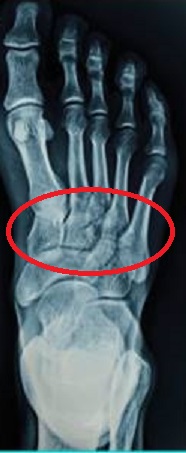Treating Trauma to the Foot – Lis Franc Injuries
 The Lis Francs Joint complex involves the bones, joints and ligaments in the middle of the foot, or “midfoot.” The Lis Francs joint is named after Jacques Lis Francs de St. Martin, a French surgeon in Napoleon’s army. After treating a soldier that caught his foot in the stirrups of his horse, he became well known for his proficiency in foot surgery.
The Lis Francs Joint complex involves the bones, joints and ligaments in the middle of the foot, or “midfoot.” The Lis Francs joint is named after Jacques Lis Francs de St. Martin, a French surgeon in Napoleon’s army. After treating a soldier that caught his foot in the stirrups of his horse, he became well known for his proficiency in foot surgery.
Today, injuries to the Lis Francs joints, including ligament tears or bone fractures, can be life-changing. Lis franc injuries may involve the spraining or tearing of ligaments with or without broken bones. Ligaments support the bones, connecting bones to bones, supporting the joints. The first three metatarsal bones articulate or connect to the three cuneiform bones, the last two metatarsals share the articulation to the cuboid bone, to make up the Lis Francs joint.
Low-energy Lis Franc injuries include twisting, falling, or misstepping. Higher energy injuries, like falling from a height or motor vehicle accidents, may also occur. Lis Franc injuries are likely to occur when the foot is forced in a downward position. With low-energy injuries, the patient may feel like they have “sprained” their foot, but a Lis Francs joint sprain is much more complex due to the midfoot ligaments needed for stability. If the ligaments tear, then the midfoot is destabilized. Stabilization of the Lis Francs joint is necessary to push off when walking.
Injuries of the Lis Francs joint include subtle tearing of the ligaments resulting in shifting of the bones, bone fractures, or complete dislocation of the bones. Lis Francs injuries result in instability and joint cartilage damage, leading to arthritis and chronic pain if untreated. Symptoms of Lis Francs injury include painful swelling and bruising at the midfoot following an injury. Patients should seek treatment following any midfoot injury that is symptomatic. Initial treatment often includes in-office x-rays, which may be followed by additional advanced imaging such as a CT scan or MRI scan. Stress imaging is also helpful for subtle injuries.
Most Lis Francs injuries require surgery. In some instances, some patients suffer from post-traumatic arthritis, which may require fusion procedures later. Open reduction internal fixation is used for some injuries to realign the bones and joints, using surgical hardware. However, some initial surgical treatments require primary fusion of the involved joints. Prognosis varies even with immediate surgical intervention, however, most patients have good functional outcomes with early identification and treatment of the injury.
If you have suffered a trauma to your foot, reach out to us immediately at 732-838-FEET. Our dedicated team of board-certified foot and ankle surgeons has the knowledge, experience and resources to treat a wide array of conditions and get you back on your feet again.
